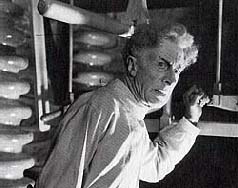Exploding the Self Destruct Lever
Myth
by
William Max Miller
Dr. Pretorius strikes a pose with the lever later
used by the
monster to blow up the lab.
Who can ever forget the explosive climax of James Whale's
Bride of Frankenstein? The monster,
after being rejected by his proposed mate, goes on a rampage through the
laboratory, smashing and throwing valuable equipment while Frankenstein and Dr.
Pretorius look helplessly on. Finally, the maddened creature reaches up toward a
lever and Dr. Pretorius shouts a futile warning: "Don't touch that lever--you'll
blow us all to atoms!" The monster pauses momentarily, lets Frankenstein escape
and run to his wife outside, then slowly, dramatically lowers his huge, scarred
hand onto the lever and pulls it downward. A titanic explosion ensues, burying
the monster, his mate, and the evil Dr. Pretorius under tons of rubble while
Frankenstein and his wife watch from a safe distance.
 End of picture--beginning of a colossal misunderstanding that has
vitiated film criticism of Bride of Frankenstein for years, and has practically been elevated
to the status of a sacred cow. I'm referring to the widespread myth that the
lever pulled by the monster during the climax was a self-destruct lever, intentionally
installed by Frankenstein or Dr. Pretorius for the intended purpose of blowing
up the laboratory, should that peculiar need ever arise. This idea is completely
taken-for-granted, and has actually influenced other mad-scientist films
(including very respectable ones like Forbidden
Planet) in which countless mad laboratories sport
self-destruct switches, buttons, and levers galore. But this traditional
interpretation of a key element in the conclusion of Bride
of Frankenstein fails to grasp a very basic fact: a lever
that happens to cause an explosion in a laboratory does not have to be a
self-destruct lever, designed
expressly for the purpose of destroying the lab.
End of picture--beginning of a colossal misunderstanding that has
vitiated film criticism of Bride of Frankenstein for years, and has practically been elevated
to the status of a sacred cow. I'm referring to the widespread myth that the
lever pulled by the monster during the climax was a self-destruct lever, intentionally
installed by Frankenstein or Dr. Pretorius for the intended purpose of blowing
up the laboratory, should that peculiar need ever arise. This idea is completely
taken-for-granted, and has actually influenced other mad-scientist films
(including very respectable ones like Forbidden
Planet) in which countless mad laboratories sport
self-destruct switches, buttons, and levers galore. But this traditional
interpretation of a key element in the conclusion of Bride
of Frankenstein fails to grasp a very basic fact: a lever
that happens to cause an explosion in a laboratory does not have to be a
self-destruct lever, designed
expressly for the purpose of destroying the lab.
The lever seen in the film is never referred to once by any of the
characters as a "self destruct lever." There are no large-lettered signs above
it reading "CAUTION: LAB WILL EXPLODE WHEN PULLED!" The only reason people think
of this lever as a self destruct device is simply because it causes destruction
after the monster pulls it down. Obviously, proponents of this Self Destruct
Lever Theory have never worked in an actual laboratory. In real labs, where many
different chemical reactions are occurring, the accidental bumping of a switch
or lever could spell disaster. Many chemical reactions are very temperamental,
and can dramatically speed up and explode if certain conditions change only
slightly.
because it causes destruction
after the monster pulls it down. Obviously, proponents of this Self Destruct
Lever Theory have never worked in an actual laboratory. In real labs, where many
different chemical reactions are occurring, the accidental bumping of a switch
or lever could spell disaster. Many chemical reactions are very temperamental,
and can dramatically speed up and explode if certain conditions change only
slightly.
With this in mind, return to the ending of Bride
of Frankenstein. Dr. Pretorius does not scream: "Don't
touch that self-destruct lever!" He
merely warns the monster to avoid a lever which he knows will result in an
explosion if pulled at that particular moment. Had Dr. Pretorius been given the
time, he might have yelled out something like this: "Don't touch that lever! The
cosmic induction coils have not sufficiently cooled down, and if you reactivate
them now, without first demagnetizing the electrode housings, you'll initiate a
chain reaction in the diffuser which will explode and blow us all to atoms!"
However, the scriptwriters wisely felt that such a mouthful would be highly
unlikely at  that dramatic moment, even for a character as eccentric as Dr.
Pretorius, and so they shortened his warning to the words that are heard in the
film. Unfortunately, this led to the Myth of the Self Destruct Lever, and has
caused countless genre critics to poke unjustifiable fun at
Bride of Frankenstein's conclusion
for years.
that dramatic moment, even for a character as eccentric as Dr.
Pretorius, and so they shortened his warning to the words that are heard in the
film. Unfortunately, this led to the Myth of the Self Destruct Lever, and has
caused countless genre critics to poke unjustifiable fun at
Bride of Frankenstein's conclusion
for years.
Whenever I hear someone talking about the infamous self destruct
lever in Bride of Frankenstein, I
always take the time to inform them that there is no such lever! In his rampage,
the emotionally distraught monster simply blundered onto a lever which, like
many other levers in any normal laboratory, could cause major problems if pulled
at the wrong time. The much-maligned self destruct lever of
Bride of Frankenstein never existed
in the film, and exists only in the misinterpretations of those who lack
familiarity with the hazards that can be found in real
laboratories.
--William Max Miller
Return to Reflections